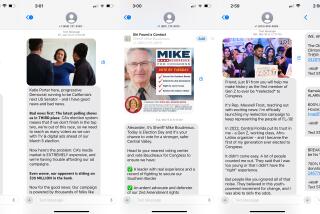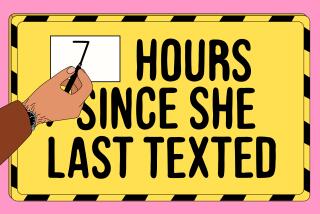Text spam driving you crazy? Hereâs how to fight back
Ding. Ding.
Itâs 3 a.m. and your phone starts making its instantly recognizable, impossible to ignore, you-just-got-a-text sound.
Your heart starts pounding. Is a loved one hurt? Is there some crisis at work?
You reach for the night stand, pick up the phone and read: âYour number was selected as our iPad winner of the day! Enter âIPADâ here to redeem!â
Refrain from hurling your phone across the room. Also, refrain from trying to acquire that iPad.
As you probably know, you are not really a winner of the day, you are the victim of mobile phone spam, a modern, insidious annoyance that is growing at an unacceptable rate.
American cellphone owners received 4.5 billion spam texts last year, according to Ferris Research, a market research firm that tracks mobile spam. Thatâs more than double the number of spam texts received in 2009.
If unwelcome texts are driving you insane, you are not alone. The FCC reports that unwanted telemarketing calls and texts were consistently in the top three consumer complaint categories in 2011.
Having your personal mobile space interrupted by a text you didnât want is always annoying, but some of these spam texts are downright dangerous. If you want to claim that âfreeâ iPad, or a $1,000 Wal-Mart gift card, youâll often be asked to divulge personal information that the spammer may sell to marketers or, worst case scenario, use to access your bank account.
And if you think replying âSTOPâ to the message will make it all go away, think again. Any reply to the message will only confirm that the spammer has hit on a working cellphone number, and he or she can sell the number to marketers.
Even if you choose to ignore the texts, they can still show up on your phone bill with charges as high as $9.99 per unwanted text.
Text spamming is illegal under the Telephone Consumer Protection Act, and the FTC is fighting some of the most egregious text spammers in court, and major mobile carriers are investing in spam-fighting technology.
In the meantime, you can take action.
First of all, make sure your mobile phone number is registered with the FTCâs Do Not Call list. This makes it illegal for a telemarketer to call or text you unless you have given them permission or they are exempt from the rules.
If you are an AT&T, T-Mobile, Verizon Wireless, Sprint or Bell Mobility subscriber, you can report spam texts to your carrier by copying the original message and forwarding it to the number 7726 (SPAM), free of charge.
If you are supremely organized, you can even file a complaint directly with the FCC, but be forewarned that youâll have a rather lengthy form to fill out. Not convenient if the text comes at 3 a.m.
Android users will find hundreds of mobile phone spam-blocking apps at the Google Play store. Mr. Number is one of the most popular of these services. PrivacyStar has the additional benefit of allowing users to file complaints against telemarketing calls to the FTC directly from the app. (This service is not yet available to report text spammers).
Unfortunately these apps are not available for iPhone users because Apple restricts this functionality.
And finally, try to motivate yourself to take a close look at your cellphone bill and make sure that you didnât incur any charges from unwanted third-party spam. If you did, call your carrier immediately and they will remove the charge from the bill.
And remember, no phone throwing!
ALSO:
What the Myspace settlement means
Give a dog an MRI, find out what heâs thinking
More to Read
Inside the business of entertainment
The Wide Shot brings you news, analysis and insights on everything from streaming wars to production â and what it all means for the future.
You may occasionally receive promotional content from the Los Angeles Times.











